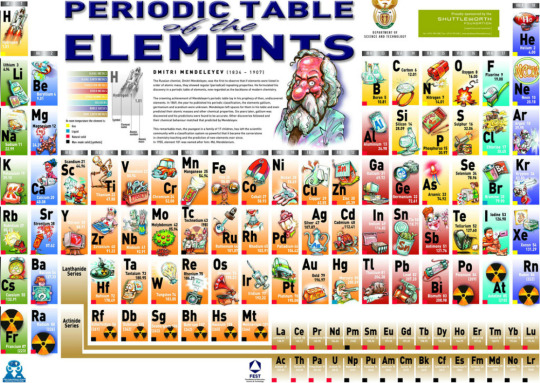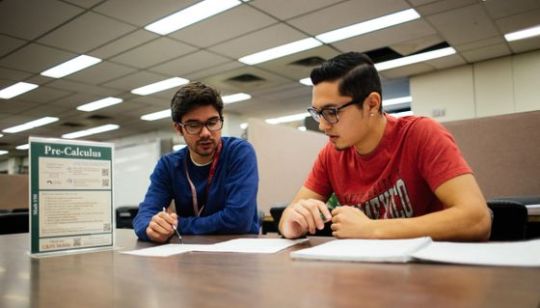Center for Academic Program Support (CAPS) is the University of New Mexico's learning assistance center for undergraduate students caps.unm.edu
Don't wanna be here? Send us removal request.
Text
6 Tips and Tricks for Biochemistry 423
by Catherine Uher and Sahlea Tubbeh, CAPS SI Leaders
1. Concept Maps Are Your Best Friend

In biochemistry, the material quickly builds up and overlaps. One way to keep from getting overwhelmed with the amount of information is to make concept maps. This will help you remember the information as well as make the information more clear and digestible. Also, once the cumulative final comes around, you will have already made clear study guides for yourself. The concept map above was done by Samantha Paltrow in Spring 2017.
2. Do Not Procrastinate

Source
Like I said, the information quickly builds up and can become overwhelming. To avoid doing 10 hour marathon study sessions the night before the exam, try doing a concept map after each lecture and keep up with weekly online quizzes which are helpful in testing knowledge. Also, study a little bit each day that way when the exam comes around, you won’t have to do tons of extra work.
3. Find a Group to Study With

Source
Finding people to study with is extremely helpful. You will learn the material better if you have people that can help answer your questions. Also, one way to test whether you understand the information is if you can explain it to someone else. Biochemistry can be overwhelming and having buddies to help motivate you will go a long way.
4. Make Time to Go to SI Sessions
As a student trying to learn the massive amounts of material that a Biochemistry class requires, I find that going to SI sessions helps to digest each pathway bit by bit. It is important to understand not only the pathway at hand, but how each pathway connects to each other. Ask these questions after you learn a pathway:
Is this pathway in FED or Fasting?
Is this anabolic or catabolic?
What are we trying to produce? Or why is this important?
How does this pathway connect to others that we have learned?

Source
5. Test Taking Techniques
With every test comes a huge bout of anxiety, sweaty palms and blanking out. Not to worry! Here are three test taking techniques that are guaranteed to get you a higher score:
Read the question. That is it. Try not to think about the answer quite yet. Once you have read the question, do you understand what it is asking you? This should be a yes or no question. Here is your test question: List all of the colors of the rainbow. Step one would be, “Yes! I understand what the question is asking.”
Review in your head all of the colors of the rainbow.
Write down the answer
Going through this process will keep your mind from blanking on the test.
6. Make-up Questions About the Material
One of the best ways to understand the material you will be tested on is to try to predict questions that you will be asked. For each lecture, write down four or five of the most important concepts you covered. Then, create a question or two about each concept you wrote down. This will help you understand the concept at a much deeper level.
Come to CAPS if you want to learn more about test taking techniques, content development or have any other questions.
5 notes
·
View notes
Text
Online Resources for Latin and Ancient Greek
by Nina Raby, CAPS Latin & Greek Tutor
Here are some free online resources to help you with grammar concepts, find works to read in Latin and Ancient Greek, and pursue independent interests. Remember that all of these resources are tools that have proper uses (always make sure you can parse or find a word before letting a word study tool do it for you!). If you are having trouble figuring out how best to use one of these resources we would love to work together with you here at CAPS to get the most out of these really awesome aids. Also, the world of Digital Humanities in Classics is growing rapidly, so if you find a particular aspect of one of these interesting it might be something you could pursue further!
Greek

Source
Ancient Lives Project: Help transcribe fragments from the Oxyrinchus Papyri online!
Online Athenaze Exercises: vocab, grammar, and reading help, and graffiti puzzle.
UCB Classics Ancient Greek Help: from a reputable source (Berkeley and Mastronarde), has study tools, tutorials, flashcards and more.
Nifty Greek: Super awesome Greek Grammar handouts made by Helma Dik, associate professor of Classics at the University of Chicago.
Latin

Source
The Latin Library: A collection of works by Latin authors, also sometimes has grammar resources.
Numen-The Latin Lexicon: Has Lewis Grammar and Lewis and Short dictionary, study tools, flashcards, a word study tool (more comprehensive than Perseus), and an English to Latin Dictionary.
Quasilium: this is an online Latin study group where you can interact with other Latin student users on a forum to ask questions, or have discussions.
Both
Perseus: A digitized collection of Ancient Greek and Latin texts and translations, as well as other tools, like word search capabilities, and word study tools. See also Perseus under PhiloLogic by the University of Chicago if Perseus doesn’t have what you’re looking for. Also be careful to use the vocabulary tool ethically and by clicking on the Middle-Liddell or LSJ link to be sure the entry is correct.
Logeion: Online dictionary. For Greek words you need to update your settings on your computer so that you have a Greek polytonic keyboard. To learn to use the keyboard, come to CAPS or Google a picture of one and print it out. Also useful because it will give you the entries from multiple dictionaries, sometimes in different languages than English (e.g. the DGE, a Spanish-Ancient Greek Dictionary), but also includes online versions of reputable dictionaries (LSJ, Middle-Liddell, Lewis and Short, etc.).
Williams Classics Online Resources: a resource list with websites for online dictionaries, information on textual transmission, bibliographies, history, archaeology, grammar, and more.
Textkit: Online top 10 Greek and Latin grammar books, readers, and answer keys.
Buzzfeed and Pinterest: These two maybe aren’t the first places to go but they often have fun classics related quizzes, articles, resources for art projects (like templates for Roman and Greek paper dolls, and making black figure amphorae), and graphic aids for learning prepositions or aspect, etc. Check them out and let us know what cool things you find!
I hope you find these useful or that they lead you to other helpful resources. Again feel free to use this as a working list; print it out, bookmark it, highlight the resources you like, add new ones you find, and let us know at CAPS if there are any changes you would make to the list! Also always make sure to double-check any information you get from these, and, again, use them ethically and mindfully, so that these can help you be an independent and efficient reader of Latin and Greek texts!
Nina Raby is a senior Classics and History major, and has been the Latin and Greek tutor at CAPS for four semesters. Nina loves to read Ovid’s work, and she wrote her senior thesis on Ovid’s Metamorphoses and Vergil’s Aeneid. She will enter into a PhD program in 2017 at the University of Virginia, with a plan to work on Latin epic poetry.
3 notes
·
View notes
Text
Musicians and Writing: Creating an Album
by Louis Bernal, CAPS Writing Tutor
Throughout the history of popular music artists have come up with ingenious ways of allowing themselves to focus on the construction of their music. Oftentimes, simply retreating to a studio to record, and being bound by set recording times and the rules of the recording company prove to be too much for some artists, who value their own sense of independence. The art of songwriting is very similar to the process many of us go through when it comes to writing papers here in college. In this post, I will look at instances of musicians employing some unique techniques to help them write music and the ways that we can implement similar methods in our own writing.

Source
After releasing two albums in rapid succession, British hard rock band Led Zeppelin decided to flip the script on the way they recorded their albums. Following almost constant touring in 1969, frontman Robert Plant and guitarist Jimmy Page left the bustling metropolis of London for the quiet of the Welsh mountains. Renting a cabin at Bron-Yr-Aur, they spent the next few weeks living “off the grid” and working on songs together. While Page and Plant would go on walks, they would stop on occasion and record snippets of songs on Page’s tape recorder. With the band’s two main songwriters out in a rustic setting, they were able to write music away from the distractions of the modern world. The songs that resulted from this trip ended up forming the basis of Led Zeppelin III. Robert Plant stated that “I hoped we could combine acoustic and electric”, to give the album a more unique sound. The album was released in October, 1970. For their next album, Page and Plant renewed their effort on songwriting and the band went to an old infirmary, Headley Grange, to record the album. It was here, by the light of a fireplace that Robert Plant wrote what many consider the band’s most famous song, “Stairway to Heaven.”

Source
Fast forward to the modern era, musicians still find unique ways to write music. In 2008, Wisconsin’s Bon Iver burst onto the indie scene with the forlorn For Emma, Forever Ago. The album was a hit and audiences gobbled up copies nationwide. They say bad things come in threes, and for lead singer Justin Vernon the album was borne from three very low points in Vernon’s life. In a span of months, Vernon’s band split up, his long term girlfriend broke up with him, and he contracted mono. He retreated to his dad’s hunting cabin in the north eastern Wisconsin woods, living there alone for three months in the dead of winter. Spending time doing simple tasks such as splitting wood and maintaining the property, Vernon was able to concentrate on finding a new musical direction. With the new focus, the album came into being thanks to 12 hour recording sessions at the cabin. Upon release, the album was critically hailed and launched Vernon into stardom.
The writing process is an important part of any written work. Artists from all levels must first plan out their works before jumping into writing. As the end of the semester draws near and tides of final essays arrive, think about the way these two famous artists worked and try to plan your writing out. Best of luck and rock on!
Louis Bernal is graduating in a week and a half with a degree in History. In his spare time he likes to find dogs to talk to, listen to great music, and worry about the Los Angeles Dodgers lack of production. He is constantly on the search for the best pizza in Albuquerque and rides around on a rusty Walmart bike with no brakes.
References
Sullivan, Paul. "Bon Iver - For Emma, Forever Ago." Paul-sullivan.com. N.p., n.d. Web. 02 Apr. 2017.
1 note
·
View note
Text
Be Rational—Use Partial Fractions While Integrating
by Cortney Reed, CAPS Math Tutor
If you’re in some sort of calculus class, you’ve probably seen lots of different integration problems. You might even encounter some that you can’t immediately solve without some sort of manipulation. If you’re trying to integrate a tricky rational function, you can follow these steps. To illustrate the steps, we’ll look at the following example:

1) Don’t feel overwhelmed! You can start by focusing on the rational function. Our goal is to simplify the function so we can integrate easily. It might be helpful to temporarily forget that the integral exists. And don’t worry—we’ll remember the integral in our last step.
2) Make sure the degree of the numerator is less than the degree of the denominator. In our example, the degree of the numerator is actually greater than the degree of the denominator, so we need to use polynomial long division to help us simplify. After doing so, we have:

3) Factor the denominator. We only need to focus on the left half for this step:

4) Write out the partial fraction decomposition. Notice how (x-1) occurs twice. That means we have:

5) Solve unknown values. All we have to do is solve A, B, and C. There are many different ways to do this, but you might want to multiply both sides of our equation by (x+1)(x-1)2. Then we have something a little easier to solve:

If you’re stuck trying to find A, B, and C, you might try plugging in random values for x that will eliminate some terms on the right-hand side of the equation. For instance, try x = -1, or x = 1. See what happens!
You will find A = -1, B = 1, and C= 2.
6) Remember the integral. Now you can re-write the original problem. Using all of the information we’ve obtained, we have:

Your hard work paid off—you can integrate now!
1 note
·
View note
Text
How to Use Testing as a Mnemonic Tool
by Yasir Hussain, CAPS Learning Strategist

Source
Using mnemonics is a way of learning where your brain associates specific information with something else; they could be events, objects, persons etc. No matter what subject you have at school, you can always use mnemonics to sharpen your memory and retain the information for a longer period of time. That is what you need in finals week, don’t you?

Source
A mnemonic device can range from a simple doodle on your notebook to a complex system developed to remember the periodic table. You can use pictures, colors or any other visual aids to help you remember. Music, for some people, works as a mnemonic tool and helps them concentrate or make relationships with the learning experience. Having said that, Testing is a great mnemonic tool that helps us learn and retain the information for a longer period of time.

Source
Testing yourself helps!
An effective method for students to improve learning is by testing their knowledge. When students are tested for knowledge, they retain additional information for a longer time than if they had repeatedly read it.
Studies on learning and memory indicate that working with the retrieval of information (by testing the information) has powerful effects on learning and long-term retention because it works as a mnemonic device. Repeated testing enhances learning more than repeated readings. In other words, repeated readings give limited benefits as compared to testing yourself for the information because of the richer mnemonic experience with learning in testing. Some researchers suggest that students do not have metacognitive understanding of the mnemonic benefits of testing.

Source
How often do you use a retrieval exercise compared to other strategies, and do you know about the mnemonic benefits of self-testing?
Practicing recall or testing yourself while studying invites feedback or knowledge about the status of your learning. However, practicing recall itself is not as effective as testing yourself!
Misconceptions of knowing follow when students’ judgements of learning are influenced by information available during reading but not available during testing. Likewise, our judgements of learning are less correct when made in study exercises than in test exercises. Students tend to be less exact at speculating the difficulty of anagrams when the solution is present than when it is not.

Source
Generally, we are less mindful of the point that practicing retrieving (as in testing) boosts learning. Teachers can inform students about the benefits of self-testing and explain why testing improves acquiring abilities. When students trust their personal experiences while they read (e.g., their ease of processing through rereading) they may fall prey to illusions of competence and believe they know the material better than they actually do.
In the finals week, the challenge is to encourage and keep students motivated to scaffold their study strategies onto theories about why a particular strategy like practicing repeated retrieval promotes learning and long-term retention.
If you think you need help with some of these strategies like test taking or better learning habits, please come see a learning strategist at CAPS and we will be happy to work with you!
References
1. Karpicke, J. D., Butler, A. C., & Roediger III, H. L. (2009). Metacognitive strategies in student learning: do students practise retrieval when they study on their own?. Memory, 17(4), 471-479.
1 note
·
View note
Text
Summer Tutoring
by KC Hodge and Crystal Bustamante, CAPS Student Manager of Training and Student Manager of Resource Representatives

Source
CAPS regretfully will not be open for tutoring services over the summer of 2017. We don’t want to leave you hanging on getting tutoring help for any summer courses you may be taking this year, so below is a list of tutoring resources to help you make it to the Fall 2017 semester!
Campus Based
1. Engineering Department: Engineering Student Services (ESS) provides tutoring for math, engineering, physics, and English courses throughout the year. Tutoring schedules are posted on their website with information on the tutor’s name, course topics, location, and days/times. For more information call (505) 277-4354 or checkout their website.

Source
2. Math Department: In Dane Smith Hall math instructors provide students with help on topics covered in calculus (162, 163, 180, and 181), algebra (120, 121, 150), and statistics (145). Tables are usually staffed from 9am to 2pm Monday through Friday on the second and third floors by the elevator. For more information call (505) 277-4613.

Source
3. Language Learning Center (LLC): If you are taking language classes this summer the LLC is a great place to find help online and potentially in-person. The LLC is a technology-enhanced language learning environment in Ortega Hall on UNM’s Main Campus that has resources for instructors and students enrolled in language classes at UNM, such as games and films. Although CAPS tutors won’t be at this location over the summer, the LLC provides numerous resources for students. Checkout this website for more information.

Source
4. Assistance Centers for Education (ACE): CNM offers tutoring services and computer labs for CNM students and community members in subjects such as accounting, applied math, biology, chemistry, physics, statistics, and English. Tutoring on CNM’s Main Campus is held in SRC-203 at these hours: Monday - Thursday, 8:00 AM-8:00 PM; Friday, 8:00 AM-5:00 PM; Saturday, 9:00 AM- 5:00 PM. Visit this page for more information.

Source
Online Resources
5. Khan Academy: Although Kahn Academy is geared towards K-12 subject matter, the videos and resources on this website can help you master the basics for you summer classes. This website has videos of teachers walking through a wide range of topics in math, science and engineering, computing, arts and humanities, and economics. You can watch the videos and also post questions if you need extra help or clarification. Here is the website.

Source
6. Coursera: If you aren’t necessarily taking courses over the summer, but you are worried about being prepared for a class in the fall, Coursera offers cheap online courses in hundreds of topics. These courses are created and led by top-ranked university professors and can cover the basics you need for other classes (such as computer programming before taking an engineering or math course) or they can cover unique, complex topics. Visit their website for more information.

Source
Other
7. Frog Tutoring: Several verified tutors are in the Albuquerque area that work through Frog Tutoring for one-on-one, in-person tutoring. Each tutor has a biography and explains what subjects they are able to tutor. You can receive a free consultation to be matched with the best tutor, however there are service fees. Subjects range from algebra, anatomy and physiology, calculus, computer programming, and writing. Call (505) 288-3484 for information on Albuquerque tutors or visit their website.

Source
8. Varsity Tutoring: This online-based tutoring company provides one-on-one tutoring in math, science, foreign languages, writing and more. This company provides services in-person and online at a small fee. Visit their website for more information, or call (505) 322-6893.

Source
KC is a junior majoring in Psychology and minoring in Criminology.
Crystal is studying Emergency Medicine and Psychology.
0 notes
Text
Advanced Nursing Drug Dosage
Part 2 of 2 by Georgiana Cox, CAPS Online Tutor

In this post I will provide examples of intravenous flow rates and pediatric dosages. First of all, dimensional analysis is my preferred method to tackle advanced dosage problems. I think this method is easiest to use to keep track of all the units and not miss any important steps.There are two types of intravenous flow rate problems you will see. Depending on the wording of the problem you may have to calculate for drops per minute or milliliters per hour. For problems asking you to calculate drops per minute a drop factor will always be provided. The drop factor is the number of drops in one milliliter used in intravenous medication administration. Usually the drop factor can be found on the packaging for the tubing you use to set up an IV administration. If you see “gtt” in a problem, that just means drops. For the problems asking you to calculate the infusion rate for an IV pump, you need to solve for milliliters per hour. In the hospital we use IV pumps most of the time to administer IV medications.
There are also rounding rules you must use when you are doing these problems to keep in mind for nursing school dosage exams. They will be provided when you take dosage exams so don't worry about memorizing them. However, here they are for your consideration:
NMNE rounding rules
Dosage less than 1, round answers to nearest hundreth
Dosage between 1-10, round answers to nearest tenth
Dosage greater than 10, round answers to the nearest whole number
For all weights, the final answer is rounded to the nearest tenth
Pediatrics round dosage answers to nearest hundredth
All IV hourly rates round to the nearest tenth
All IV drops per minute rates round to the nearest whole number
Intravenous flow rates
1. Hespan 500 ml is ordered to be infused over 3 hours. The drop factor is 15 gtt/ml. How many drops per minute should be given to infuse the total amount of Hespan over 3 hours?
2. The physician orders cefuroxime 1 g in 50 ml of normal saline solution to be infused over 30 minutes. The tubing drop factor is 60 gtt/ml. How many drops per minute should be given to infuse the total amount of cefuroxime over 30 minutes?
3. Infuse 1000 ml of lactated Ringer’s solution over 12 hours. How many ml/hr should the IV pump be programmed for?
4. The physician orders morphine sulfate 15 mg/hr IV. Given a bag with a concentration of 100 mg of morphine sulfate in 200 ml of D5W, how many milliliters per hour should the IV pump be programmed for?

Pediatric dosages
1. The physician orders Keflex 250 mg po four times a day for a child weighing 50 pounds. You have Keflex 250-mg capsules. The recommended daily po dosage for a child is 25 to 50 mg/kg/day in divided doses every 6 hours.
a. What is the safe recommended dosage range for this child?
b. Is the order safe?
c. If yes, how many capsules will you administer?
2. The physician orders Benadryl 25 mg IV every 6 hours for a child weighing 50 pounds. You have available Benadryl 12.5 mg/ml. The recommended daily dosage for a child weighing more than 12 kg is 5 mg/kg/24 hrs in four divided doses.
a. What is the safe recommended single dosage for this child?
b. Is the order safe?
c. If yes, how many milliliters will you prepare?
3. A child is to receive vancomycin 750 mg IV piggy back every 6 hours. The child weighs 68 pounds. The recommended dosage of vancomycin is 40 to 60 mg/kg/24 hr.
a. What dose per kilogram per 24 hours is the child receiving?
b. Is the order safe?

If you are looking at some of these problems and saying to yourself, “What the heck?”— don’t worry. It will all make sense when they start teaching you this stuff in nursing school 😊. In nursing school you have to take dosage exams every semester and get a 90% or higher to proceed in the program. If you aren’t familiar with dosage problems already I hope this two part blog post helps you get your “feet wet” with these kinds of problems.
For more practice, visit the following resources. Some of these practice questions and answers are resources created by other nursing schools so feel free to skip over school specific information and look at the practice questions and answers: Mighty Nurse UKY Bridge Nursing Program Nurseslabs Good luck!
Georgiana Cox is a level 4 nursing student attending the University of New Mexico.
2 notes
·
View notes
Photo

Add us on Snapchat! Username: unmcaps https://www.snapchat.com/add/unmcaps
1 note
·
View note
Text
Tips for Applying Medical School
by Paul Ratmeyer and Bud Salmon, CAPS SI Leaders

Source

Source

Source

Source

Source

Source

0 notes
Text
How to Feel Comfortable When Presenting
by Sarah Haquani, CAPS Writing Tutor

Finals. The time where we as students allow ourselves full access to Netflix and procrastination. We all have upcoming papers, final exams, and presentations.
Wait...presentations.
You may have just broke out in a cold sweat realizing you have to present very soon, and you say you won’t panic. As part of the writing team at CAPS, here are the top five things you can do to mentally prepare yourself for your presentation:
1) The first thing is to get down to business; your presentation is not just for your grade anymore. Create each slide like an index card by making short bulleted points that you can substitute instead of index cards. This prevents the audience from getting bored, and straining the audience’s eyes.
2) Add a splash of color! Avoid picking simple black and white colors (unless otherwise instructed by your professor). Do, however, choose a nice variety of colors that complement the material you are presenting.

Source
3) Get away from PowerPoint! Explore! Be free! With the great vast ocean of the internet, look for fun ways to present. A few of these websites include: Prezi, Google Slides, and PowToon. Engaging your audience doesn’t have to be a colorless process; the more fun you have creating your presentation, the less stressed you will feel.
4) Present to an imaginary audience. I know, this sounds like the typical and cliché thing to do when presenting. However, the new twist on this would be to present to either a group of friends, your pet, or even an empty room. Note: the most important thing to remember here is to plan to present in the same exact way that you would to your class. Later on you will remember how relaxed you felt when presenting for fun, and that will reflect in how you present.

Source
5) Lastly, the most important tip for when you are really nervous! All of us no matter how well rehearsed get clammed up from time to time. It’s human nature, so don’t feel bad! I am sure that we have all had the chance in our lives to explain something we know to someone who was unaware of the expertise we had on a subject. Just imagine you are presenting to an audience that has no idea what subject you are talking about. Pretending that you get to talk about this wild new idea will help you feel at ease when presenting.
Sarah Haquani is a writing tutor at the Writing and Language Center at CAPS. She is a senior at UNM studying political science and international studies. Sarah is also a lover of dogs, various cooking shows, and loves the variety of making puns.
2 notes
·
View notes
Text
Munchies from Around the World
(To accompany your study sessions for language finals) by CAPS Language Team
بليلة/Balilah: Arabian Gulf

Jake’s tea and Balilah on his last day in Saudi Arabia
���Balilah is originally from Jordan but is a popular dish in the Arabian Gulf. It’s made of boiled chickpeas which are mixed with garlic, salt, cumin and olive oil.” ---Jake, Arabic tutor
Hanuta: Germany

Source
“Hanuta, usually written as hanuta, is an abbreviation for Haselnusstafel, which are a delicious German sweet treat that’s not quite as filling as a cake. If the packaging looks vaguely familiar to you, that’s because this snack is made by the same company which makes the ever-popular Kinder Eggs. Enjoy the two wafers and the hazelnut-chunk-and-cocoa spread in between.” ---Casey, German & Writing tutor
Empanadas: Argentina and New Mexico

Source
“Empanadas are a staple if you ever visit Argentina. Unlike the empanadas you can find here in New Mexico, Argentine empanadas have a meat filling. For the best dining experience, enjoy empanadas de carne (beef) and a glass of your favorite cold drink.” ---Ryan, Assistant Coordinator of Writing & Language

Source
“For something closer to home, try the New Mexican variety of empanadas, which have sweeter crust and are filled with jelly. Enjoy empanadas de cereza (cherry) and a cup of warm coffee for the perfect breakfast or dessert.” ---Ryan Here’s a how to video to make these delicious treats.
La Galette des Rois: France

Source
“La Galette des Rois, or ‘king cake,’ is a fluffy, flaky pastry that can be found in every French bakery during the month of January. In France, it is eaten in light of the Epiphany. Hidden inside are two small figurines and those who find them are coronated with paper crowns. This is a great treat that is available even after the winter holidays.” ---Savannah, LLC Location Supervisor
おにぎり/Onigiri: Japan

Source
“Onigiri, or rice ball, is a popular food in Japan to grab when you are hungry between meals. The simplest one can be made of cooked rice and salt, but you can also season the rice with different flavors, wrap them with seaweed, or put various things such as pickled plums, grilled salmon, etc. inside. Try them with a cup of hot green tea!” ---Motomi, Student Manager for Language Learning
СУШКИ/Sushka: Russia

Source
“Here is a little Russian snack that is very popular to drink tea with. It is called SUSHKA. It is something like a small dried bagel or a bigger and sweeter pretzel. SUSHKA (singular) or SUSHKI (plural) can be plain, with poppy seeds, or vanilla. Really good with tea and can be purchased at Istanbul Market in Albuquerque.” ---Svetlana, English as a Second Language and Russian tutor
うまい棒/Umai-bou & ポッキー/Pocky: Japan

Source 1, Source 2
“Umaibou and Pocky are cheap (usually costing less than a dollar), and can easily be bought from any nearby convenient store in Japan. Because of their packaging and simple shape, they are good to eat while studying. Umaibou are kind of like a giant Frito chip in the shape of a small cylinder, and would be a good choice for those who prefer savory. Pocky shares a similar stick shape, but would be better for those who prefer a sweet flavor to snack on.” ---Ari, Japanese tutor
Brigadeiro: Brazil

Source
“Brigadeiro is one of the most popular and beloved desserts in Brazil. These chocolate bonbons have a fudgy texture and are extremely easy to make, with just four ingredients: condensed milk, butter, cocoa powder and chocolate sprinkles.” ---Laima, Spanish & Portuguese tutor
Pan con Tomate: Spain

Source
“Pan con tomate, also known as Pan a la Catalana, is a typical Spanish tapa (a small snack often served with a drink). The bread is toasted, rubbed with tomato and fresh garlic, and drizzled with olive oil and salt. Many people enjoy it as an appetizer or as a breakfast food, and it is often served with cured ham or cheese.” ---Laima
Palma ac me: Ancient Rome

Source
“Ancient Romans would eat dried fruits with honey during the main meal of the day (cena) which would normally be very long-lasting and contain several courses (see Petronius’ Satyricon for a satirical example of the extravagance of a Roman feast). This is a photograph of dates with honey which would have been a common presence at a dinner party as a precursor to the main part of the meal (sort of like an appetizer).” ---Nina, Latin and Greek tutor
Σταιτίτας/Staititas: Syracuse, Ancient Greece (attested in Athenaeus’ Deipnosophists)

Source
“Staititas are sort of like pancakes, and were probably mainly eaten for breakfast. Athenaeus tells us that they were made by pouring moist spelt-flour dough out into a frying pan and adding honey, sesame-seeds and cheese on top.” ---Nina
Carambars: France

Source
“Carambars are a chewy candy from France. Originally, they were caramel-flavored, but now they are offered in a wide variety of flavors such as peach tea and cotton candy. Inside their wrappers are jokes, which are often considered to be very childish in quality. You can order them on Amazon if you ever want to try them out!” ---Hazel, French & Writing tutor
蛋烘糕/dān hōng gāo: China

Source
“Dān hōng gāo, or house special pancake, is very famous traditional Chengdu snack which could be dated from Qing Dynasty in China. Nowadays it could be found at food booths of everywhere in Chengdu. It can be filled with meat, Chinese ham, red beans, sesame, etc., and tastes a little crisp outside and super moisture inside. Taking some pancakes with a glass of milk in the morning could be a good breakfast. And you can also sit down and have some house special pancake with a cup of tea to enjoy sunshine at afternoon.” ---Wenhao, Chinese tutor
Conchas: Mexico

Source
“Conchas, also known as Pan Dulce, refers to a sweet bread that originated in Mexico. Conchas are inexpensive and are popular in some states, like New Mexico, here in the U.S. While at home, enjoy a concha with a warm cup of coffee for breakfast or a late-night snack.” ---Ana, Spanish & Writing tutor
Pizza al taglio: Rome, Italy

Source
“Despite there being packaged merendine ‘snacks’ along with other snack food in Italy depending on the regions, a very common one is that of the pizza al taglio (pizza by the slice, and literally ‘pizza by the cut’). This type of pizza was invented in Rome and is found most often in pizzerie in Rome and in a few other places around Italy. There are a wide variety of pizzas and they are baked in rectangular trays to then be cut at any size and sold by weight. You can choose to sit down and eat it, though it is common to have it wrapped so half of the pizza is sticking out, and eat it while walking. It is also different than the pizza tonda ‘round pizza’ which was originally invented in Naples, is found more in sit down restaurants and it is often thinner than the pizza al taglio.” ---Daisy, Italian & Writing tutor
#language#food#snacks#health#arabic#spanish#french#german#russian#italian#latin#greek#japanese#chinese#portuguese#UNM#CAPS
1 note
·
View note
Text
Properties of Logarithms
by Tia Nicole Reid, CAPS Math Tutor
Are logarithms giving you a difficult time? They are definitely something that takes some getting used to, so do not be discouraged! Here we will review the properties of logarithms that will help you demolish your homework assignment.

Source
First, let’s consider some important simplification rules. These come in to play when you are asked to simplify a given logarithm.
1) loga1=0 This rule is stating that no matter the base of your log, if you are evaluating at the value of 1 it will always equal zero.
EXAMPLE: log51=0 log91=0 log21=0
2) logaa=1 This rule is stating that if the base of the log matches the value you are evaluating at then it will always be equal to 1.
EXAMPLE: log55=1 log99=1 log22=1
3) a^(logaM)=M This rule is like the one above stating that if the base of the logarithm and the value it is being evaluated match then the solution is the exponent value. Rule 2 is a special case of this, with r=1.
EXAMPLE: 5^(log57)=7 9^(log913)=13 2^(log23)=3
4) logaar=r This rule is like the one above stating that if the base of the logarithm and the value it is being evaluated match then the solution is the exponent value. Rule 2 is a special case of this, with r=1.
EXAMPLE: log557=7 log9913=13 log223=3
Next, let’s consider the rules used during the expansion or compression problems. These come in to play when you are asked to “write the logarithm as a sum or difference of logarithms” or when you are asked to “write as one logarithmic expression”.
5) loga(MN)=logaM+logaN This rule states that if you have one logarithm with two (or more) pieces being multiplied then you can expand it to be a string of sums. Also, it states that if the logarithms that are being added all have the same base then they can be compressed into one expression.
EXAMPLE: log5(x2-4)=log5[(x+2)(x-2)]=log5(x+2)+log5(x-2)
6) loga(M/N)=logaM-logaN This rule states that if you have one logarithm with two pieces divided then you can expand it to be a difference of two logarithms. Also, it states that if the logarithms that are being subtracted from each other have the same base then they can be compressed into one expression.
EXAMPLE: log9(x/2)=log9x-log92 log3[(x-5)/5]=log3(x-2)-log35
7) logaMr=rlogaM This rule states that if you have a logarithm with an exponent attached you can bring the exponent value down in front and multiply it by the logarithm, this aids in simplification purposes.
EXAMPLE: log2x3=3log2x log3(x+1)7=7log3(x+1)
Always remember that you can swing by CAPS on the third floor of Zimmerman Library for additional assistance, or give us a call if you have any questions at (505) 277-7205. Also, you can check out our services, hours, and locations at caps.unm.edu.
0 notes
Text
Finding Your Study Spot
by Holly Brause and Sonny Hakuani, CAPS Learning Strategists
We all have a favorite place to study, but sometimes it either isn’t available or we might just be feeling like something new. This blog post suggests some of our favorite places to study and includes some helpful tips about how best to study in each of them!
Home
There are many benefits to studying from home. You can roll out of bed, keep your PJs on, not brush your hair, have easy access to the refrigerator, etc. Plus, many of us live far from campus or don’t like to work in public spaces. But working from home has its own set of challenges. Many students find that they get too distracted trying to work at home. This can be because of interruptions from family, kids, roommates or pets.

Source
But, even if you live alone, some people find that there are too many easy distractions in their living environment: you start noticing that floor really needs to be swept, get up to start that load of laundry that has been on your mind, or you decide to take a little break and watch a TV show and get sucked into an all-day marathon.

Source
If you know from experience that you really don’t focus well working from home, it’s okay! You can seek out other places that help your focus and productivity, but a few suggestions might help if you want to study more efficiently from home: 1. Designate a study area - If you have the room, try to make yourself an area that you use just for studying by converting a small room into an office, or by using some kind of barrier to separate your sleeping area from your working space. This can help you to mentally prepare to study by physically entering a separate space.
2. Set a schedule for yourself - Decide on a length of time that works for you, like an hour or two hours depending on your ability to concentrate, and decide to do nothing but study during that time. I keep myself from getting up to do other things by just keeping a little to do list on my desk. If I feel tempted to get up and water my plants because I remember it needs to be done, I just jot it down on my list of things to do after my study hour is up.
3. Tell your family or roommates your schedule - Ask them to avoid interrupting you (except in case of emergency) until your study time ends and post that time on your door. Clearly communicating when you need uninterrupted study time, and especially when you will again be available, encourages your roommates to save that hilarious meme they wanted to show you for another half an hour, and lets you work in peace.
Coffee Shops
As an introvert and someone who is easily distracted, I find it very difficult to work in public spaces like coffee shops, but many of my friends love it. Being away from all of their distractions at home but not being in a stuffy library really helps them concentrate on their studies. Plus, easy access to copious amounts of caffeine! But even more than the caffeine, many of my more extroverted friends say that they can feed of the productive energy of other strangers also reading, writing, of studying quietly (or not so quietly) around them. One of my friends even loves working in airports will all of that human energy buzzing around her. If this kind of environment suits your study needs, great! Start exploring your local coffee shops and stake out your favorite corner somewhere.

Source
My advice for this kind of study setting is simple: coffee shops are mixed social and study areas, so bring a set of headphones! Even those who love to study around others can get derailed when someone sits right by them with their BFF they haven’t seen in AGES and need to loudly recount every intimate detail of their life. Be prepared armed against such intrusions with your favorite study music!
UNM Library Group Study Rooms
Did you know that you can reserve group study rooms at four of the libraries at UNM? Zimmerman, Centennial, Parish, and the Fine Arts Libraries all offer group study rooms that can be reserved online here.
There is also information on the website that shows which ones have flat panel screens, DVD/VHS players, projectors and more so that you kind easily find one that suits your group’s needs. I personally prefer the Fine Arts rooms because their huge windows face the Sandia Mountains, and you can gaze out jealously at everyone playing in the sun on Johnson Field. When you reserve a room online, you can see how many people each room can accommodate and select one appropriate for your group size. Each reservation can only be made for up to two hours, so if you know your group will need more time, work with another member of your group to reserve the same room starting right after yours expires.

Source A tip for studying in the group rooms: Studying with your peers and friends can be great for so many reasons, but there is a risk of it turning into just social time. To keep yourself and your group on track, try to structure your time between social and study. For example, communicate with your group that the first half an hour you will share snacks and catch up, and then dive into work for the remaining hour and a half – and stick to it! Or, use the Pomodoro App and divide your study session into 25 minute quiet study time, punctuated by 5 minute breaks for chatting. Whatever strategy you develop, make sure you communicate with your group and hold each other accountable for doing the work! That is the beauty of group study!
The SUB Balcony
This study spot is perfect for people who prefer some ambient people, but still at a distance. It is located on the third floor of the sub and can be accessed from the east wall glass doors that are between the conference rooms. Some things to consider:
1. It's outside so it's subject to weather!
2. It's kind of a pocket-like area and it catches the wind even if it's just lightly breezy
3. You can hear everything that's happening outside the east side of the sub. It's faint most of the time but if there's an event and you like it to be quiet, it might not be the best spot at the time.
4. If you don't mind a little breeze, make sure you have some paper weights or your thesis could become a paper airplane.
Hidden Spots Outside of Zimmerman Library
Looking for a spot outside so you can write your paper in the weather that is finally getting warm? Well, outside of Zimmerman Library, on both the north and the south sides, there are two wonderful spaces that are perfect if you’re looking to study with some fresh air. The location on the south side of the library is a relatively isolated area with benches circled around a small fountain. The spot on the north side, which is just outside the north exit to the left, has nice shade trees and does a good job of blocking the wind if there is any.
Things to consider:
1. The spot on the south side has no tables, just benches. The wifi is as solid as Lobo wifi can be on any given day but there are no plugs if you are running low on battery power.
2. The spot on the north has wood tables and the area itself is slightly fenced off so if you would like to study with a little more peace and quiet than say, the duck pond, this could be the place for you.
And of course…
Study at CAPS!
Regardless of what your major is or whether or not you need help right away, CAPS is one of the best places to study on campus because there are so many resources available to you all in one place. Whether you need help with time management, chemistry, or figuring out how to make a study plan for an upcoming exam, you’re never more than a few feet away from a CAPS peer tutor. Located on the third floor of Zimmerman, you can get some exercise on your way up the stairs and have a productive study session all in one go.

Source
Tips for studying at the CAPS Drop-In Lab:
1. It can be a busy location so bring headphones if you need to listen to music and focus.
2. If you would like a little more quiet, on the same floor, there are desks that line the walls around the book stacks and you can study there until you want to work with someone in person over in the drop-in lab.
3. If you don’t like to walk around with a heavy laptop but still need one for your homework, you can check one out with a resource representative or use one of the computers set up for students.
These are just a few of our favorite places to study that many students not always think about when they need to be productive finish an assignment. Want to help us build the list? Share your favorite study spot!
0 notes
Text
How to Use LoboTrax
by KC Hodge and Crystal Bustamante, CAPS Student Manager of Training and Student Manager of Resource Representatives
Registration for summer and fall semester courses are just around the corner! The first thing you need to know about registering for classes here at UNM is how to understand your LoboTrax audit. If you’re new to UNM, just declared your major, or even if you’re a semester away from graduating, LoboTrax may still be confusing for you—but don’t worry! Below are some helpful tips to get you through registration.
1. Log on to myUNM First things first, you need to know where your LoboTrax Audit is. You’ll need to sign in to myUNM using your NetID (the first part of your email) and your password. You will then click on the quick link for LoboTrax.

2. Submit an Audit
Click “Submit an Audit” in order to see what your degree plan looks like, or what potential degree plans could look like. Each audit will also include the university-wide requirements (such as core classes, the total number of credits, the total number of upper division credits, etc.).

If you’ve already submitted an audit in the past, you can either submit a new audit (your old audit information will most likely be saved still) or click on “View Submitted Audits” to see what you’ve submitted in the past.
3. Choose a Program
At this point you can choose any program you may be thinking of from the list provided. If you are completely lost on what to take, check out http://degrees.unm.edu/ for detailed information on the over 200 undergraduate degree options. Here you can explore by college, by interest, and alphabetically!

If you’re unsure what program you need to be in, but you have a good idea of what you want to do, or what classes you’d like to take, you can talk with an advisor to learn more about your options. This is especially helpful if you are pairing an uncommon major and minor, or crossing colleges (an Arts and Sciences Major with Speech and Hearing Minor). For those kinds of special cases, or just to learn more about what is available to you, talk with your college’s advisor or the advisor for the department you’re interested in (i.e. College of Arts and Sciences advisor, or a Psychology advisor). You can also ask your friends to see what advice has been given to them from fellow students, professors, and advisors!
4. Run Audit
Once you’ve narrowed down what kind of program you’re interested in, choose the “Run Selected Program” option and fill out the required information. This includes what college your program is in (such as Education, Fine Arts, or Arts and Sciences). Then you can choose your major. Note that nothing will pop up if you don’t first choose a college; also, all the options are in abbreviations (i.e. CLST-LANG for Classical Studies with a Language concentration). If you’re unsure what an abbreviation stands for, you can look through the UNM Course Catalog. The degree section most commonly only has one option to choose from based on the information you provide for your college and major, however, for majors in the College of Arts and Science, you have to choose between a BA (Bachelor of Arts) and BS (Bachelor of Science). This is usually determined by which major and minor you plan to take (two science programs result in a BS, and a science with an art program results in a BA). Once all the fields are filled, run your audit! Click “View Audit” in black to see your results.

5. Core and University Requirements
The first seven choices with drop-down tabs will fall under University Requirements. UNM requires that all students be admitted to a degree granting college (which happens after you declare a major with your advisor and you meet that college’s preadmission requirements). UNM also requires a minimum of 120 credit hours to graduate with a bachelor’s degree and a cumulative GPA of 2.00. A diversity course of 3 credit hours, and a variety of other core classes that roughly total to 37 credit hours are required (more information here).
6. Xs and Checks
The final thing to understand is which requirements you still need to fulfill in order to obtain the degree you chose.

Red X’s mean there is still unmet requirements in that section
Lighter green with three dots means after you complete your classes in progress, you will meet that section requirement.
Green check marks mean you have completed all required courses for that section
Pay close attention to what each of your drop-down tabs are labeled to ensure that your major and minor are correctly represented in your audit. Generally, majors require 36 credit hours while minors require 18 credit hours; these numbers are estimates, please check your degree plan for more specific information. If you notice that your minor seems to be more than 18 credit hours, talk with an advisor to ensure your minor wasn’t accidentally entered as a second major. If you notice any other little quirks, or if you’re curious about what classes might meet multiple requirements, schedule an appointment with an advisor, or email [email protected] using your UNM email account.
KC is a junior majoring in Psychology and minoring in Criminology.
Crystal is studying Emergency Medicine and Psychology.
1 note
·
View note
Text
Introductory Nursing Drug Dosage
Part 1 of 2 by Georgiana Cox, CAPS Online Tutor
Interested in nursing school? Well an integral part of the program is mastering drug dosage problems. Calculating drug dosages is an important part of nursing because we need to be able to interpret an order from a physician and deliver the correct dose to the patient. It is important to be comfortable with converting metric measurements. The most common metric prefixes you will see and will probably have to convert between is mirco-, mili-, centi-, and kilo-.

Source
You will also need to know and be able to convert household, apothecary and metric measurements. The most common ones I have used are:
2.2 pounds = 1 kilogram for weight based drug dosages
5 ml = 1 teaspoon, and 15 ml = 1 tablespoon for liquid drug dosages
Okay, now that we have covered some basic information you need to know it’s time for some practice questions! I will provide examples of oral and parenteral dosage problems. Parenteral dosages are medications administered via intramuscular, subcutaneous, or intravenous routes. There are several methods for calculating drug dosages, however dimensional analysis is my preferred method because I think it is the easiest. I like it because once you set up the problem you just plug it into the calculator and get the right answer every time.
The left side of the equation is what you are solving for. Then on the right side of the equation you should put the information you gather from the problem that matches what you are solving for. The unit of what you are solving for should match the denominator of the fraction from the information from the problem. Set up the rest of the problem so the unwanted units cancel out and you are just left with the answer!
If you are having a hard time visualizing what I'm saying, then don't fret! I have some examples below and in the second installment of this post to refer to. Some of the other methods require multiple steps especially for the more complex problems and it’s easy to get things mixed up and make a mistake. When you get in the program you will be exposed to the other methods and you can choose which method works best for you.
Oral dosage problems
1. The order states Augmentin 500mg po (by mouth) daily. The drug is supplied in 250-mg tablets. How many tablets will the nurse administer?
2. The physician orders aspirin 975 mg po four times a day. Aspirin 325-mg tablets are available. How many tablets will the nurse administer?
3. The physician orders phenobarbital 45 mg po two times a day. Phenobarbital elixir, 20 mg/5ml, is available. How many milliliters will the nurse administer?

Parenteral dosage problems
1. The physician orders Apresoline 30 mg IM (intramuscular). Apresoline 20mg/ml is available. How many milliliters will the nurse administer?
2. The patient may receive Dilaudid 3 mg IM every 3 hours for relief of pain caused by a total hip replacement. Dilaudid is supplied in 1-ml ampules containing 4 mg. How many milliliters will you administer?

There are other important aspects of calculating drug dosages such as safety in medication administration, interpretation of physician’s orders, and reading medication labels which you will learn about when you enter nursing school. This blog post is not all inclusive for everything you need to know about dosage in nursing school, however I hope this post helps gives you a leg up on mastering drug dosage problems when you enter nursing school.

Source
In the next part of this series I will provide many different examples of advanced drug dosage problems you will be expected to know how to do in the later semesters of the program. The focus of these posts is to provide example problems and how to solve them. Please refer to other sources if you want to know additional information.
Stay tuned for Advanced Nursing Dosage Part 2!
Georgiana Cox is a level 4 nursing student attending the University of New Mexico.
0 notes
Text
The Basics of Cancer Genetics
by Kylie Disch and Lexi Mang, CAPS BIO 202 SI Leaders
The basic definition of cancer is a disease that is characterized by uncontrolled cell growth. Our bodies have mechanisms to control cell growth under normal conditions, but sometimes the machinery does not work. These situations are called mutations, and can be substitutions, chromosomal rearrangements, deletions, etc. Most cancers are somatic, meaning that they are not part of the cells that are part of reproduction. Only about 5% of these mutations can be passed to offspring.

Source
All cancer cells have two basic properties:
● Cell growth and division that is unregulated (abnormal)
● Metastatic spread (grows past where it started, to other parts of the body)
Most cancers cause the growth of tumors, which can be classified as benign (unregulated mass of cells that cause no serious harm) or malignant (metastasized cells invade other tissue and cause life-threatening problems). Both types have to start out from the same type of cell and accumulate numerous mutations.

Source
Parts of our normal machinery to ensure cell growth include:
● Proto-oncogenes that encode for proteins necessary to go through the cell cycle. Mutated alleles of these are called oncogenes and code for the hyperactivity of these proteins.

Source
● Tumor suppressor genes that encode for proteins that regulate whether a cell keeps going through the cell cycle or not. Mutations in these cause for uncontrolled cell proliferation.

Source
There is one gene that stands out in the world of cancer genetics, and that is TP53. Over 50% of human tumors have some sort of mutation or deletion of this gene. The role of TP53 is to make p53, a protein that checks for any damage in the DNA and allows for repair, or if it cannot be repaired, it sends the cell into apoptosis (programmed cell death).

Source
Some things to keep in mind about cancer:
● The older you get, the more times your body has had to replicate your DNA, meaning there is a higher risk of mutations, and consequently cancer, as you age.
● Carcinogens also put you at risk (these are agents that can cause cancer, such as radiation). Every day we walk out in the sun, we are exposed to UV radiation, which damages our DNA. Fortunately, our bodies are effective at catching this and fixing it, but sometimes mutations can keep this from happening. This is when you develop skin cancers (this is why sunscreen is important!)
● Some viruses, such as human papillomavirus (HPV) can put you at risk by encoding a protein, E6, which binds and inactivates p53.

Source
For more information about this, some great resources include: PubMed, a research article database available free to UNM students through the university libraries, your 202 SI leaders, your biology or biochemistry professors, and various websites also include extensive research sections, such as The American Cancer Society.
2 notes
·
View notes
Text
Sharing the Table: Engaging Dinner Conversations and Literature Reviews
Part 3 of 3 in the Research Process series by Ryan D. Smith, CAPS Assistant Coordinator of Writing & Language

Source
Imagine attending a dinner party. You sit at a table with several other individuals, all actively engaged in a stimulating political conversation. It starts out as a good, lively discussion, but soon develops into a monologue from the gentleman at the end of the table, and suddenly everybody tunes out. It’s annoying, one-sided, and – well – boring. This dinner could have been much more enjoyable if everyone had had a chance to talk.
A literature review, or discussion of your sources, goes the same way. If you give each of your authors a monologue, so to speak, your literature review will be choppy and more difficult to follow. It is as if you are a moderator for a panel discussion, and you need to give each of your sources their due share in the discussion. The best way to avoid rambling on about a single author is to find recurring themes that come up in your readings, build an outline based on these themes, and offer a well-rounded description of each theme.
Rather than discussing each source individually throughout your paper, you want to organize your paper based on ideas. So the first thing to do is to come up with several recurring ideas presented in your sources. Say, for instance, that you are writing a paper about institutionalized racism. Some themes that might come up in your sources could include education, diversity in the workplace, the justice system, police brutality, and psychological aspects of racism. Not all of your sources will touch on every theme you come up with. But try to come up with themes that connect each source to at least two others. If you don’t have enough sources to discuss a certain theme, it’s a good idea to look for more sources that relate to it.
Once you’ve come up with your themes, organize your notes so that you can see which of your sources relate to each theme. I recommend using either color-coded notecards or a spreadsheet. If you use a spreadsheet, create a row for each of your sources, and a column for each of your themes. If you are using notecards, use a separate color for each theme, and make a notecard for each theme saying which sources are relevant to that topic.

Spreadsheets are useful just for storing and organizing your notes. You don’t need to worry about adjusting the cells so that you can read everything; you can simply double-click on any cell that you want to read, and the full entry will open up.

After you’ve organized all of your notes by theme, create an outline for your literature review. Find the best order that you can present the various ideas logically. Remember that you will not be summarizing each source one by one, but will be going back and forth between your sources. In our example paper, we could potentially start out with police brutality and justice, have a section on psychology, and then end with the importance of diversity and education. Next, start developing a logical order for your notes and commentary within each topic. Make sure to include all of your notes and commentary about each topic in your outline, so that you can see which sections are missing information, or which sections need to be expanded a little further.
There are a few things to think about when expanding a section. Firstly, it is important to include enough information from your sources to give your reader an overall understanding of the topic. This includes anything that might be foundational, and all arguments relevant to your research topic. Secondly, you want to make sure you have enough to say about each topic. Try adding your own commentary between citations. You can discuss how they are relevant to your research, or analyze their arguments and methods. Thirdly, a well-rounded argument should present all of the major sides of an issue. Not only does this make your argument more credible, but it also gives your reader the opportunity to make up their own mind about the topic. It strengthens your own argument further by supporting claims for and against each side with evidence. In our example paper, for instance, we would also want to include articles that deny the need for police reform, or that discuss the role of perception bias in judgment decisions.
Being an objective researcher means you allow the evidence to inform your opinion, rather than choosing evidence to support an opinion you’ve already developed. By presenting a well-rounded argument, you will both transition more smoothly between ideas and give your reader more substance on which to form their opinion. Adding tension to your paper will also make it more interesting to read. After all, the best dinner conversations have a little bit of heat.

Ryan D. Smith is the Assistant Coordinator of the Writing & Language Program at CAPS, and an M.A. Candidate in the Department of Linguistics. He enjoys posting photos of his cooking on Facebook and avoiding controversial dinner conversations.
#writing#outline#literature review#research#scholarly#researching#sources#academia#organize#CAPS#UNM
0 notes